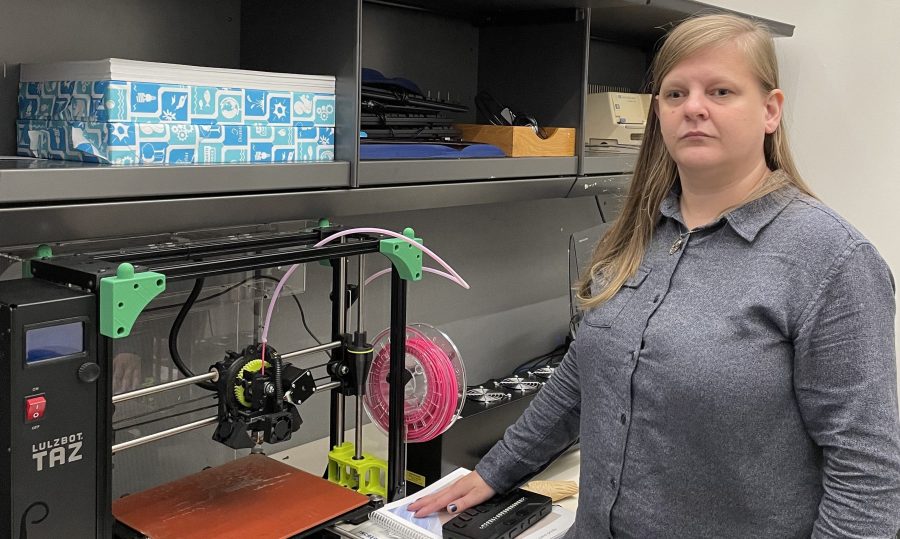For blind people, technology can offer a way to perceive images through touch

For almost 200 years, the Braille system has turned the written word into raised bumps that blind people can read. This works well for text, but not for images.
With a device called an embosser, there’s a way around that. The embosser pricks and crimps three-dimensional dots and lines on paper to produce a tactile image, allowing people to perceive pictures through touch.
Chancey Fleet is a technologist at the Andrew Heiskell Braille and Talking Book Library, part of the New York City Public Library. She’s Blind and teaches other low-vision and blind patrons to print their own images. She talked to Sasha Fernandez of “Marketplace Tech” at the library.
“I’m Chancey Fleet. I’m the assistive technology coordinator here at New York Public Library. My job is to make sure library patrons know what kind of technology and literacy options are available and make sure that they are empowered.
“The average blind or low-vision person might not come across as many graphics as they should, and what I want to do here is make sure that library patrons can have a straight path from their curiosity, their want, their need to have an image to getting that image under their fingertips.

“What we do here that’s different is make sure that people have access to the means of production. We have a really high-quality Braille and tactile graphics and embosser called the Columbia 2 that anyone can come in just like you would use a print printer and use.”
Fleet turns on the graphics embosser, which makes a high-pitched loading noise.
“I have here a file — it has popped up in my web browser — I’m gonna go to print. And we’re gonna do it.”
The embosser emits halting high-pitched tones as it prints a map of Flatbush in Brooklyn. Fleet holds the paper as it comes out and begins to feel the textural elements on the page.
“Right, looking good. I see the Braille starting to come out. The paper coming out of here is not hot, because this one just embosses lots and lots of pixels, so this is the most powerful hole punch in the world.”
The embosser makes one last high-pitched noise and stops.
“And we have our map.

This one is showing an area around Flatbush. There’s just a little bit of Braille on the edges of the map, and all we have here are really spare, bold street lines. And the purpose of this map is to see intersections and streets and how they relate.
“Graphic embossers, the very least-expensive ones, start around $1,500. And they go up into the tens of thousands from there. We gathered all these things here because they are important and they are expensive, and we want to make that economic barrier go away. I find that sometimes folks are isolated for a very upsettingly long time.
“I could tell you what I think technology holds in 10 or 20 years, and I think it’ll be really exciting. But I’m more interested in making sure that the people who are living on this planet today, losing their vision or living as blind folks today, have equal access to the resources that we all deserve.”
Related links: More insight from Kimberly Adams
The design of the map, and the process Chancey Fleet uses to create it, come from the advocacy group LightHouse for the Blind and Visually Impaired, based in San Francisco. The organization has a page where you can order a map and learn the basics of how to make one yourself. To learn more, visit the Lighthouse T-MAP webpage.
The embosser isn’t the only piece of equipment at the Andrew Heiskell Library available to blind and low-vision patrons. Visitors can also learn how to use 3D printers and experiment with a swell form machine, which transforms two-dimensional drawings into tactile images.
Information on the library’s resources and how to connect with Fleet for tech coaching is available online at Library Services.
Lastly, the National Library Service for the Blind and Print Disabled has a summary from 2020 on the types of Braille embossers and how much they cost, if you know someone in the market for one. Review this information on the Braille embosser resource page.
But as Fleet explained, this equipment isn’t cheap. The Columbia 2, like the one she used, costs around three thousand bucks. A higher-end version is $45,000.
So for many, that means printing at the library for now.
The future of this podcast starts with you.
Every day, the “Marketplace Tech” team demystifies the digital economy with stories that explore more than just Big Tech. We’re committed to covering topics that matter to you and the world around us, diving deep into how technology intersects with climate change, inequity, and disinformation.
As part of a nonprofit newsroom, we’re counting on listeners like you to keep this public service paywall-free and available to all.
Support “Marketplace Tech” in any amount today and become a partner in our mission.












